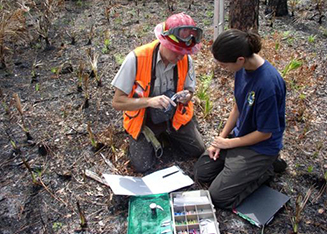Eagle Management
Both bald eagles and golden eagles are protected by the Bald and Golden Eagle Protection Act (Eagle Act) and the Migratory Bird Treaty Act (MBTA).
As part of implementing and enforcing these laws, the Service monitors the health of bald and golden eagle. Bald and Golden Eagles: Status, trends, and estimation of sustainable take rates in the United States (Status Report) (3.6MB) is a compilation of the most current research on the population status and trends of bald and golden eagles. The report estimates population sizes, productivity, and survival rates; cumulative effects to local area populations; and effects of unauthorized take of golden eagles. This report serves as the biological basis for the Service’s regulatory management framework.
Updated Eagle Nest Survey Guidance
The U.S. Fish and Wildlife Service announces (242.2KB) new guidance (218.6KB) regarding eagle nest survey areas. The updated recommendation is to conduct field surveys for eagle nests only within 2 miles around the project footprint. This guidance supersedes the recommendations in the Service's 2013 Eagle Conservation Plan Guidance.
A Framework for Permitting "Low-risk" Wind Projects
The Service will soon announce a proposed, streamlined eagle incidental take permitting process for wind energy projects that are considered “low-risk” to eagles. Although the "low-risk" framework has not been finalized or formally proposed yet, the Service has prepared a presentation (22.4MB) outlining the approach. Once downloaded, use the controls in the lower left hand corner of the presentation to advance the slides. Audio will begin on the third slide. A closed caption version of this presentation will be made available shortly.
We expect to officially announce the proposed framework through a Federal Register notice in early 2019.
Bald Eagle And Golden Eagle Electrocution Prevention In-lieu Fee Program
The Bald Eagle And Golden Eagle Electrocution Prevention In-lieu Fee Program (Eagle ILF Program) is authorized by the U.S. Fish and Wildlife Service (USFWS) to sell compensatory mitigation credits for bald and golden eagle take. The Eagle ILF Program is currently the only third-party mitigation banking option available specific to eagles and authorized by USFWS to offset incidental take. (Note: USFWS authorization of the Eagle ILF Program does not constitute blanket endorsement of Eagle Electrocution Solutions, LLC, or its parent company.)
Updated Collision Risk Model Priors for Estimating Eagle Fatalities at Wind Energy Facilities
Guidance and Tools
National Bald Eagle Management Guidelines (144.4KB) - These Guidelines were developed by the U.S Fish & Wildlife Service to advise landowners, land managers, and others who share public and private lands with Bald Eagles about when and under what circumstances the protective provisions of the Eagle Act may apply to their activities. The Guidelines are intended to help people minimize such impacts to Bald Eagles, particularly where they may constitute "disturbance" which is prohibited by the Eagle Act.
Eagle Incidental Take Permit Questions and Answers (114.7KB) - This document addresses frequently asked questions about Eagle Incidental Take Permits.
Resource Equivalency Analysis (REA) Tools - The REA tools have been developed for calculating the compensatory mitigation needed to offset permitted take (via direct mortality, disturbance, or territory loss) using power pole retrofits. The REA outputs estimate the number of high-risk poles that would need to be retrofitted per eagle taken. For golden eagles, there is a regulatory requirement for a mitigation ratio of 1.2:1. The REA tools can be downloaded by clicking on the following links:
The REA is based on the current understanding of GOEA and BAEA life history inputs, effectiveness of retrofitting high‐risk electric power poles, the expected annual take, and the timing of both the eagle take permit and implementation of compensatory mitigation. As would be expected, the estimated number of eagle fatalities and the permit renewal period affect the number of poles to be retrofitted. Delays in retrofitting would lead to more retrofitted poles owed. New information on changes in the level of take, understanding of the eagle life history, or effectiveness of retrofitting could be used to change the number of retrofitted poles needed for compensation. Finally, while only electric pole retrofitting is presented here in detail, the REA metric of bird‐years lends itself to consideration of other compensatory mitigation options.
Eagle Conservation Plan Guidance (2MB) - This Guidance provides specific in-depth guidance for conserving Bald and Golden Eagles in the course of siting, construction and operation of wind energy facilities.
Eagle Incidental Take Permit Regulations
On December 14, 2016, the U.S. Fish and Wildlife Service announced a final rule revising the regulations for permits for incidental take of eagles and take of eagle nests. The Service analyzed various alternative management options and rule revisions, including the final rule revisions, in a programmatic environmental impact statement (PEIS).
Among other revisions, the final rule addresses criteria for permit issuance, compensatory mitigation requirements, permit duration, and data standards for submitting permit applications.
Final Eagle Incidental Take and Eagle Nest Take Regulations
Final Programmatic Environmental Impact Statement (3.9MB)
For more information, visit the website for this rulemaking at http://eagleruleprocess.org. These documents are also available on www.regulations.gov at Docket No. FWS–R9–MB–2011–0094.
Permits
- Eagle Permit Application and Report Forms
- Injury and Mortality Reporting (IMR) System Instructions (for eagle permit holders instructed by their permit conditions to report eagle injury/mortality information to the Service)
- Regulations for Eagle Permits
- Regional Permit Offices
- Migratory Bird Permits Home


